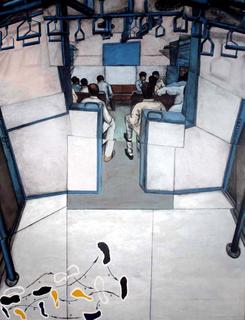
Mumbai, for last ten years, has seen an emergence of alternative, subversive trends in art that enable and empower an artist to operate as a cultural practitioner of critical theory. Tushar Joag is not only a ‘product’ of this period, but also one of its many architects. Keeping aside his credentials as sculptor and installation artist, he switched his energies to conceive study-circles for familiarizing art-students with the socio-political realities and sometimes even to generate political action. Many artists would still know him as the man who, with his colleagues at the Open Circle, facilitated the visual art component at World Social Forum IV, Mumbai. Thus, Tushar typifies an artist who lives beyond the white cube of an art gallery.
Tushar’s recent show, “Willing Suspension” (at Gallery Chemould, August 5-26), marked his comeback to the white walls!
Alongwith a website representation of his larger project, the show had three kinds of works with different levels of intention : two canvases that pictured what a Mumbai local train is, with an instructional diagram of the footwork one has to make for a clever entry into a crowded train, a video (monoscreen) that explored the suburban rail traffic as a battleground of violence and peace in the city, and a sculptural installation that allured with fantasy-like innovations to board and commute on a train’s outer walls .
While the canvas and even the video were highly based on observed reality, the sculptural installation was an artist’s contribution. At once, it had overt ‘modernistic’ intentions to make human life easier, and post-modern subversive approach to what is being perceived as a ‘way of life’ …many a ‘Mubaiya public’ travel on the train’s outer walls with one foot on the window, but with a constant danger of life. Tushar’s attempt, through his deemed ‘devices’, was to eliminate that danger. Yet, by the very fact that this device is impractical and only a fantasy, Tushar had made his point. Instead of constructing some devices for a better world, he is into deconstruction of the reality that exists.
A more localized (no pun intended on the ‘local’ trains) observation of these works would help us to see the artist as a commuter himself, fighting and inescapable battle with a situation that his country, his city and his disposition as a suburban man. Where the agenda is to board a train and make oneself comfortable while in a train. What an accomplishment it is when MOST of the commuters meet this agenda, win the battle that they are forced to fight? Yes they do, even without the knowledge of their victory. Tushar’s work, then, has the value of artistic intervention that celebrates this unclaimed victory.
For the global audience that Tushar by now is familiar with, the work might infuse some insights in a local (pun sustained, not overruled!) life-situation. A fantasy as it may seem from a distance, a distance that we normally keep from the gallery walls, has already had entered the domain of reality through a clever footwork. The viewer no longer remains a distanced witness to what is shown. S/he is bound to be empowered to observe the ‘everyday’ of Mumbai closely.
- Abhijeet Tamhane, Mumbai, August, 2005